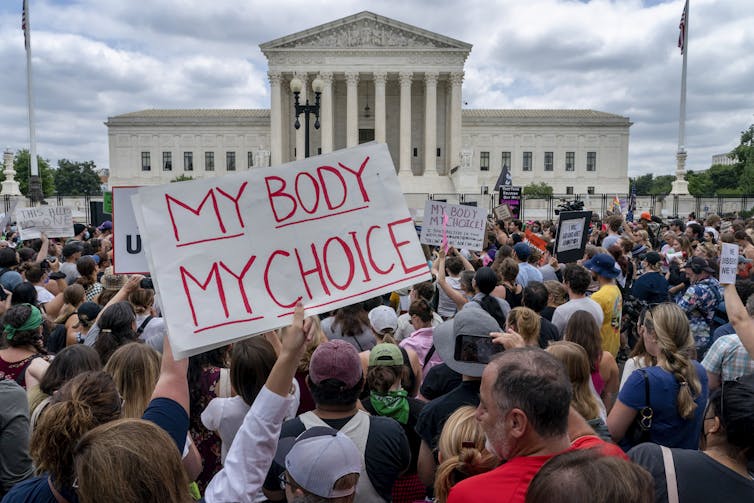is a PhD candidate in the School of Nursing at .
As an abortion care provider in Canada, I feel deep solidarity with colleagues south of the border and terror for their patients after the U.S. Supreme Court overturned Roe v. Wade, the 1973 ruling that the U.S. Constitution afforded protection to the right to abortion. Individual states now may ban abortion outright — .
Abortion care affirms the dignity and autonomy of patients and translates into not only physical and mental health but also .
Providers and policymakers in Canada can and must respond to U.S. abortion bans by expanding access to care here.
Abortion law in Canada
In Canada, abortion is . Abortion is health care and is no more governed by criminal law than knee surgery or intravenous antibiotics. There are no legal limits on gestational age, or mandatory waiting periods or requirements that youth seek parental consent.

Abortion in Canada is publicly funded like most physician- or hospital-provided services, with a few exceptions. And since 2017, all primary care providers, including family physicians and nurse practitioners, have been authorized (except in ˛ĎłÜĂ©˛ú±đł¦) , which is drug-induced rather than surgical.
Because there is no abortion law in Canada, there is no law for conservative politicians to demand be reformed to limit access. There is no law that providers of care must tiptoe in between to avoid prosecution.
Access to abortion care
In the past seven years, logistical access to abortion in Canada has improved significantly:
and solidified surgical services at three hospitals.
Prince Edward Island .
Nova Scotia to a single toll-free line.
Most importantly, the ability to prescribe medication for abortions has .
Even : as providers became more familiar with telemedicine, many felt comfortable moving to “no touch” or “low touch” medication abortion prescribing, without requiring blood work or ultrasound.
Because pandemic inter-provincial travel restrictions limited the ability to refer patients elsewhere if they were past local gestational age caps, hospitals in several provinces made the necessary infrastructural and training adjustments to extend the gestational ages to which they would provide care.
Inequalities remain
But serious limits on abortion access in Canada remain. This is a huge country, and people living in rural, remote and underserved areas face enormous travel burdens to access care.
These burdens are greatest for . And access challenges may be greater if we suddenly see an influx of demand for care from .
Because health care is administered at the provincial/territorial level, access and medical practices among the provinces/territories vary widely, and unjustly. This is the case for all kinds of health care, not just abortion — but abortion is basic and common care, not neurosurgery.
Consider how there are 49 (surgical) abortion sites in — by far the highest number of access points — but ˛ĎłÜĂ©˛ú±đł¦ has the lowest rate of uptake of because of rigid requirements about prescribing authority. Meanwhile, although there is only one surgical abortion site in P.E.I., more than half of abortions on Island are .
In , 95 per cent of (publicly funded) surgical abortion takes place at the freestanding family practice clinic, Athena. Yet New Brunswick has kept a perverse piece of legislation on the books for decades, 84-20 Schedule 2 a.1 of the denying public insurance for surgical abortion outside of a hospital building.
in Canada with a uterus will have an abortion in their lifetime. The arrangements for care should not be so convoluted and unequal.
Action to ensure access
There will undoubtedly be escalating rhetoric from anti-choice politicians in the wake of the fall of Roe. Now is the time to leap forward in terms of access. Health-care providers, policymakers, activists and everyone in Canada can channel into meaningful and specific actions to enthusiastically expand abortion services.
We need to ensure all medical and nursing schools include to increase provider knowledge, competence and confidence with abortion care and reduce geographic disparities.
should be authorized not only to prescribe medication abortion but to perform aspiration (surgical) abortion. must get on board with welcoming primary care providers as medication abortion prescribers.
We should nurture for mentorship and support, to improve confident uptake of no-touch mifepristone prescribing and availability of abortion in rural, remote and underserved communities.
We must have for everyone, and explore offering contraception and mifepristone over the counter, as we do with Plan B.
We must make sure every person understands how abortion care works here, normalize it as a health service, and resist any attempt to bind it up that could someday be altered or taken away.
Poverty, stigma, racism and gender violence are barriers to abortion in Canada. If we are worried about threats to access, these are what we need to fight.![]()
This article is republished from under a Creative Commons license. Read the .

